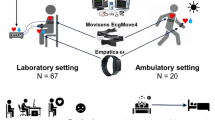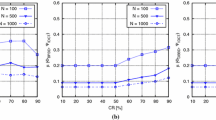Abstract
It is essential to perform real time monitoring of the cardiac and physical activities in patients with cardiovascular diseases. Thus, the objective of this research was to develop a one-lead electrocardiogram (ECG) patch monitor for the detection of heartbeats and the calculation of frequency-domain parameters (as a mental index) of heart rate variability in real time. Consisting of a microcontroller with ARM 3 core and embedded with a three-axis accelerometer, this monitor could real time provide some additional information related to user’s daily physical activities. Main specification items of the ECG patch monitor were found to meet the standards of the International Electrotechnical Commission for medical electrical equipment and ambulatory electrocardiography systems (Holter ECG system). Its ingress protection rating, for instance, was found to be 68°. Thus, the ECG patch monitor allowed users to put it on all day, and to do various kinds of exercises or sports, even including swimming. In order to let users feel comfortable, it was designed to be of light weight and could run for over 24 h. A 4 GB flash memory was installed in the apparatus for data storage. The performance of the heartbeat detection algorithm was evaluated by using the MIT-BIH Arrhythmia Database. The results showed a sensitivity of 99.7% and a positive predictivity of 99.0% for the cardiac rhythm detection. Meanwhile, a mobile application algorithm allowed users to adjust some functions of the ECG patch monitor and to display the heart rate, mental index, and physical activities in 1 day. When users felt chest discomfort, they could push a button on the ECG patch monitor and 1-min ECG signals would be sent to the mobile device via Bluetooth 4.0. Based on the testing results, the patch-based ECG apparatus may be suitable for different types of users to apply in a ubiquitous healthcare environment, especially for those with a potential cardiac disease.










Similar content being viewed by others
References
Wang, Y., Heinen, S., Wunderlich, R., & Heinen, S. (2015). A wearable wireless ECG monitoring system with dynamic transmission power control for long-term homecare. Journal of Medical Systems, 39, 35. https://doi.org/10.1007/s10916-015-0223-5.
Friesen, G. M., Jannett, T. C., Jadallah, M. A., Yates, S. L., Quint, S. R., & Troynagle, H. (1990). A comparison of the noise sensitivity of nine QRS detection algorithms. IEEE Transactions on Biomedical Engineering, 37, 85–98.
Thakor, N. V., & Zhu, Y.-S. (1991). Applications of adaptive filtering to ECG analysis: Noise cancellation and arrhythmia detection. IEEE Transactions on Biomedical Engineering, 18, 785–794.
Ka, A. K. (2012). ECG beat classification using waveform similarity and RR intervals. Journal of Medical and Biological Engineering, 32, 417–422.
Liu, S. H., Cheng, D. C., & Lin, C. M. (2013). Arrhythmia identification with two-lead electrocardiograms using artificial neural networks and support vector machines for a portable ECG monitor system. Sensors, 13, 813–828.
Moavenian, M., & Khorrami, H. (2010). A qualitative comparison of artificial neural networks and support vector machines in ECG arrhythmias classification. Expert Systems with Applications, 37, 3088–3093.
Homaeinezhad, M. R., Ghaffari, A., & Rahmani, R. (2012). Review: Multi-lead discrete wavelet-based ECG arrhythmia recognition via sequential particle support vector machine classifiers. Journal of Medical and Biological Engineering, 32, 381–396.
Liu, S. H., & Cheng, W. C. (2012). Fall detection with the support vector machine during scripted and continuous unscripted activities. Sensors, 12, 12301–12316.
Fortune, E., Lugade, V., Morrow, M., & Kaufman, K. (2014). Validity of using tri-axial accelerometers to measure human movement-Part II: Step counts at a wide range of gait velocities. Medical and Engineering and Physics, 36, 659–669.
Chang, K. M., & Liu, S. H. (2011). Wireless portable ECG and a tri-axis accelerator implementation and application on sleep activity monitoring. Telemedicine and e-Health, 18, 177–184.
Okada, Y., Yoto, T. Y., Suzuki, T. A., Sakuragawa, S., Sakakibara, H., Shimoi, K., et al. (2013). Wearable ECG recorder with acceleration sensors for monitoring daily stress. Journal of Medical and Biological Engineering, 33, 420–426.
European Society of Cardiology and North American Society. (1996). Heart rate variability: standards of measurement, physiological interpretation, and clinical use. European Heart Journal, 17, 354–381.
Taelman, J., Vandeput, S., Vlemincx, E., Spaepen, A., & Huffel, S. V. (2011). Instantaneous changes in heart rate regulation due to mental load in simulated office work. European Journal of Applied Physiology, 111, 1497–1505.
Liu, S. H., Lin, T. H., & Chang, K. M. (2013). The physical effects of aromatherapy in alleviating work-related stress on elementary school teachers in Taiwan. Evidence-Based Complementary and Alternative Medicine, 2013, 853809. https://doi.org/10.1155/2013/853809.
Liu, S. H., Cheng, D. C., Wang, J. J., Lin, T. H., & Chang, K. M. (2015). Effects of moderate exercise on relieving mental workload of elementary school teachers. Evidence-Based Complementary and Alternative Medicine, 2015, 192680. https://doi.org/10.1155/2015/192680.
http://www.analog.com/media/en/technical-documentation/data-sheets/AD8232.pdf.
Fortune, E., Lugade, V., Morrow, M., & Kaufman, K. (2014). Validity of using tri-axial accelerometers to measure human movement—Part II: step counts at a wide range of gait velocities. Medical Engineering & Physics, 36, 659–669.
Chang, Y. H. (2012). A hand-held real-time heart rate variability monitor. Thesis for Degree of Master in Chaoyang University of Technology.
Liu, S. H., & Chang, Y. J. (2009). Using accelerometers for physical actions recognition by a neural fuzzy network. Telemedicine and e-Health, 15, 867–876.
Wolf, P. A., Abbott, R. D., & Kannel, W. B. (1991). Atrial fibrillation as an independent risk factor for stroke: The Framingham Study. Stroke, 22, 983–988.
Lamassa, M., Di Carlo, A., Pracucci, G., Basile, A. M., Trefoloni, G., Vanni, P., et al. (2001). Characteristics, outcome, and care of stroke associated with atrial fibrillation in Europe: Data from a multicenter multinational hospital-based registry. Stroke, 32, 392–398.
Christopher, B. G., & Luciana, V. (2012). Newer oral anticoagulants should be used as first-line agents to prevent thromboembolism in patients with atrial fibrillation and risk factors for stroke or thromboembolism. Circulation, 125, 159–164.
Seet, R. C., Friedman, P. A., & Rabinstein, A. A. (2011). Prolonged rhythm monitoring for the detection of occult paroxysmal atrial fibrillation in ischemic stroke of unknown cause. Circulation, 124, 477–486.
Kop, W. J., Stein, P. K., Tracy, R. P., Barzilay, J. I., Schulz, R., & Gottdiener, J. S. (2010). Autonomic nervous system dysfunction and inflammation contribute to the increased cardiovascular mortality risk associated with depression. Psychosom Medicine, 72, 626–635.
Cuomoa, S., De Pietrob, G., Farinab, R., Gallettic, A., & Sanninob, G. (2016). A revised scheme for real time ECG signal de-noising based on recursive filtering. Biomedical Signal Processing and Control, 27, 134–144.
Pan, J., & Tompkins, W. J. (1985). A real-time QRS detection algorithm. IEEE Transactions on Biomedical Engineering, BME, 32, 230–236.
Trahanias, P. E. (1993). An approach to QRS complex detection using mathematical morphology. IEEE Transactions on Biomedical Engineering, 40, 201–205.
Mehta, S. S., & Lingayat, N. S. (2009). Identification of QRS complexes in 12-lead electrocardiogram. Expert Systems with Applications, 36, 820–828.
Yeh, Y. C., & Wan, W. J. (2008). QRS complexes detection for ECG signal: The difference operation method. Computer Methods and Programs in Biomedicine, 91, 245–254.
Li, C. W., Zheng, C. X., & Tai, C. F. (1995). Detection of ECG characteristic points using wavelet transforms. IEEE Transactions on Biomedical Engineering, 42, 21–28.
Lobodzinski, S. (2013). ECG patch monitors for assessment of cardiac rhythm abnormalities. Progress in Cardiovascular Diseases, 56, 224–229.
http://www.irhythmtech.com/zio-solution/zio-patch/index.html.
http://www.medtronicdiagnostics.com/us/cardiac-monitors/seeq-mct-system/index.htm.
Acknowledgements
This research is in part funded by the Ministry of Science and Technology in Taiwan under Grants MOST 103-2632-E-324-001-MY3 and MOST 105-2221-E-214 -012-MY3.
Author information
Authors and Affiliations
Corresponding author
Ethics declarations
Conflict of interest
No Conflict financial interests exist.
Rights and permissions
About this article
Cite this article
Liu, SH., Wang, JJ., Su, CH. et al. Development of a Patch-Type Electrocardiographic Monitor for Real Time Heartbeat Detection and Heart Rate Variability Analysis. J. Med. Biol. Eng. 38, 411–423 (2018). https://doi.org/10.1007/s40846-018-0369-y
Received:
Accepted:
Published:
Issue Date:
DOI: https://doi.org/10.1007/s40846-018-0369-y




